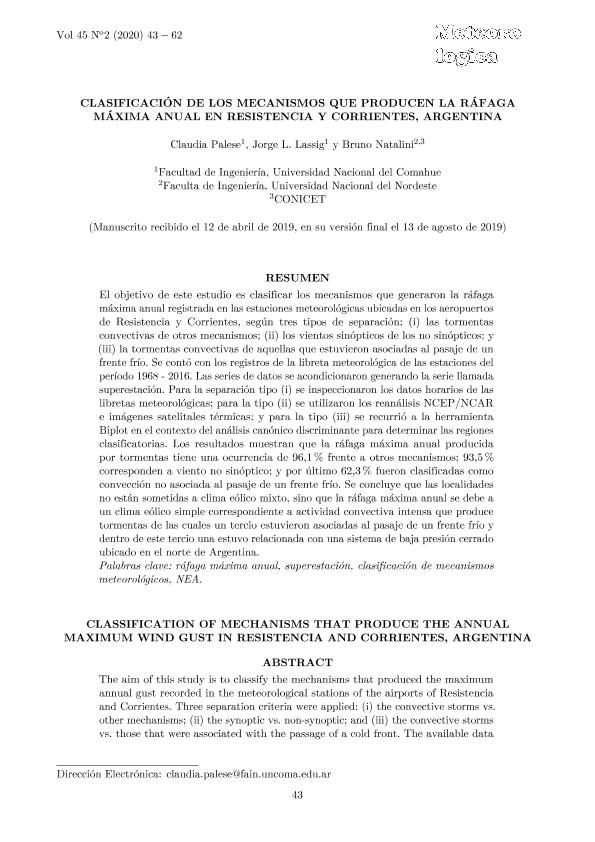Artículo
El objetivo de esteestudio es clasificar los mecanismos que generaron la ráfaga máxima anualregistrada en las estaciones meteorológicas ubicadas en los aeropuertos deResistencia y Corrientes, según tres tipos de separación: (i) las tormentasconvectivas de otros mecanismos; (ii) los vientos sinópticos de los nosinópticos; y (iii) la tormentas convectivas de aquellas que estuvieronasociadas al pasaje de un frente frío. Se contó con los registros de la libretameteorológica de las estaciones del período 1968 - 2016. Las series de datos seacondicionaron generando la serie llamada superestación. Para la separacióntipo (i) se inspeccionaron los datos horarios de las libretas meteorológicas;para la tipo (ii) se utilizaron los reanálisis NCEP/NCAR e imágenes satelitalestérmicas; y para la tipo (iii) se recurrió a la herramienta Biplot en elcontexto del análisis canónico discriminante para determinar las regionesclasificatorias. Los resultados muestran que laráfaga máxima anual producida por tormentas tiene una ocurrencia de 96,1 %frente a otros mecanismos; 93,5 % corresponden a viento no sinóptico; y porúltimo 62,3 % fueron clasificadas como convección no asociada al pasaje de unfrente frío. Se concluye que las localidades no estánsometidas a clima eólico mixto, sino que la ráfaga máxima anual se debe a unclima eólico simple correspondiente a actividad convectiva intensa que producetormentas de las cuales un tercio estuvieron asociadas al pasaje de un frentefrío y dentro de este tercio una estuvo relacionada con una sistema de bajapresión cerrado ubicado en el norte de Argentina. The aim of this study is to classify the mechanisms that produced the maximum annual gust recorded in the meteorological stations of the airports of Resistencia and Corrientes. Three separation criteria were applied: (i) the convective storms vs. other mechanisms; (ii) the synoptic vs. non-synoptic; and (iii) the convective storms vs. those that were associated with the passage of a cold front. The available data sets were the Daily Registers of the stations from 1968 – 2016. The data series were conditioned to generate a series called superstation. For classification (i) the hourly measured data were inspected; for classification (ii) NCEP/NCAR reanalysis and thermal infrared remote sensing were used; and for classification (iii), the Biplot tool was used in the context of canonical variate analysis to determine the classificatory regions. The results show that the annual maximum gust produced by storms have an occurrence of 96.1 % compared to other mechanisms; 93.5 % correspond to non-synoptic wind; and 62.3 % were classified as convection not associated with the passage of a cold front. It is concluded that Corrientes and Resistencia are not subject to mixed wind climate, that is, the maximum annual gust is due to a simple wind climate corresponding to intense convective activity that produces storms, of which one third was associated with the passage of a cold front and within of this third, one was related to a closed low pressure system located in the north of Argentina.
Clasificación de los mecanismos que producen la ráfaga máxima anual en Resistencia y Corrientes, Argentina
Título:
Classification of mechanisms that produce the annual maximum wind gust in Resistencia y Corrientes, Argentina
Fecha de publicación:
11/2020
Editorial:
Centro Argentino de Meteorólogos
Revista:
Meteorológica
ISSN:
0325-187X
e-ISSN:
1850-468X
Idioma:
Español
Tipo de recurso:
Artículo publicado
Clasificación temática:
Resumen
Archivos asociados
Licencia
Identificadores
Colecciones
Articulos(IIDTHH)
Articulos de INSTITUTO DE INVESTIGACION PARA EL DESARROLLO TERRITORIAL Y DEL HABITAT HUMANO
Articulos de INSTITUTO DE INVESTIGACION PARA EL DESARROLLO TERRITORIAL Y DEL HABITAT HUMANO
Citación
Palese, Claudia; Lassig, Jorge Luis; Natalini, Bruno; Clasificación de los mecanismos que producen la ráfaga máxima anual en Resistencia y Corrientes, Argentina; Centro Argentino de Meteorólogos; Meteorológica; 45; 2; 11-2020; 43-62
Compartir




